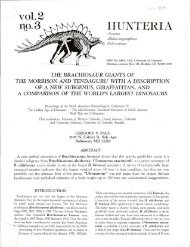THE MANY MYTHS, SOME OLD, SOME NEW, OF ... - Gregory S. Paul
THE MANY MYTHS, SOME OLD, SOME NEW, OF ... - Gregory S. Paul
THE MANY MYTHS, SOME OLD, SOME NEW, OF ... - Gregory S. Paul
You also want an ePaper? Increase the reach of your titles
YUMPU automatically turns print PDFs into web optimized ePapers that Google loves.
88<br />
G. S. PAUL<br />
the per unit energy demands of flying are very high. However, it is easier to flythan to<br />
walk with an erect gait, or to run with any gait. Do not believe this? A child can build<br />
a good working model of an airplane and get it to fly, including even a helicopter<br />
model with complex aerodynamic controls. The AeroVironment QN project built a<br />
fairly realistic flapping flight model of a giant pterosaur whose basic flight stability<br />
was provided by a low power, on board, computer. Only a modest investment of<br />
resources would result in much higher fidelity bird or pterosaur models. In contrast,<br />
it has not yet proven possible to construct a robot that walks with a speed and agility<br />
anywhere near that of a human, even on a level floor (Moravec, 1988).<br />
Both flying and erect walking are highly dynamic processes. One reason that flight<br />
is fairly easy is because flying machines and beings are usually built to be inherently<br />
stable, it takes effort to tip them over. In contrast, walking and running are<br />
controlled falls, with disaster looming at every step. In addition, air is a relatively<br />
simple and open medium to progress through. Walking beasts are continually<br />
threatened with a complex surface topography that can trip them up. The ease of<br />
flight is confirmed by the rapidity with which insects learned to fly after they took up<br />
terrestrial habits, and by the small brains found in insects and pterosaurs. These<br />
brains are modified for flight purposes, especially for processing the optical data so<br />
critical for aerialists, but their overall computing power is no greater than it is in<br />
sprawling gait insects and reptiles (see above).<br />
Flight evolved after walking simply because it is necessary to do the latter before<br />
one can do the former.<br />
<strong>THE</strong> PNEUMATIC BONES AND AIRSACS <strong>OF</strong> BIRDS AND<br />
PTEROSAURS GREATLY REDUCE <strong>THE</strong> MASS <strong>OF</strong><br />
<strong>THE</strong>IR SKELETONS, AND <strong>THE</strong>IR SPECIFIC GRAVITIES<br />
Myth: In order to reduce their mass and improve flight performance, birds have thin<br />
walled, air sac filled bones. These adaptations were taken to extremes in pterosaurs.<br />
Reality: Prange et al. (1979) have shown that, as a percentage of total body mass, the<br />
skeletons of nonflying and flying birds and mammals make up similar percentages of<br />
total mass at any given body size. Likewise, the airsacs of flying and nonflying birds<br />
alike lower their specific gravities only about 10% compared to other tetrapods<br />
(<strong>Paul</strong>, 1988a). The body volume/mass ratios of even albatross and frigate birds<br />
indicate at most a 25% reduction in density due to internal airspaces. There is no<br />
a-priori reason to believe that pterosaurs had significantly lower skeletal weights or<br />
specific gravities (see below).<br />
BIG PTEROSAURS WERE ULTRALIGHT AIRBEINGS<br />
Myth: Large pterosaurs such as the pteranodontids and azhdarchids were much<br />
lighter in mass relative to their wingspans and areas than are birds of similar size.<br />
Their thin walled bones were also lighter and weaker than those of birds. These<br />
factors indicate that large pterosaurs were slow, fragile fliers (Bramwell and<br />
Whitfield, 1974; Desmond, 1976; Brower, 1983; Pennycuick, 1986).<br />
Reality: Most volume estimates of the body of Pteranodon (including mine) agree<br />
that, relative to wingspan-area, it had a body about as large as more gracile birds.<br />
The body and legs of azhdarchids are even larger relative to their wings. This means<br />
that the very low mass estimates assume unrealistically low specific gravities of









